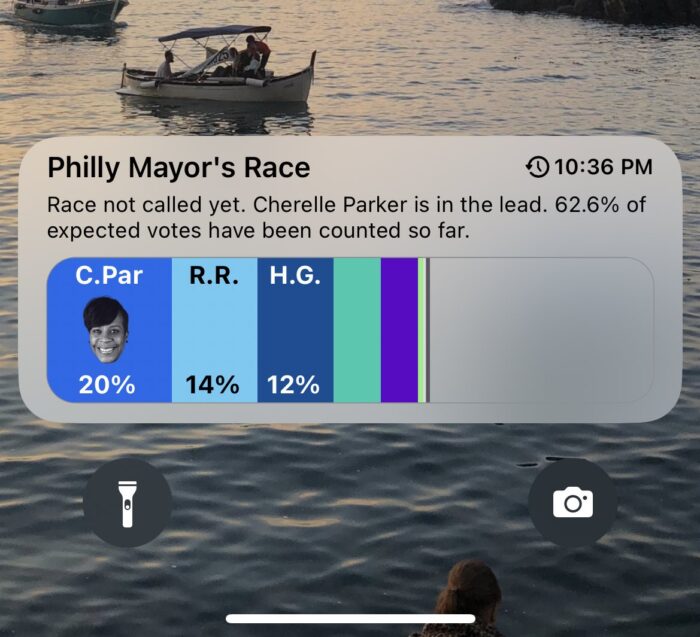
When The Philadelphia Inquirer launched an election night widget earlier this month, they were fairly confident it would work smoothly.
After all, they’d already road tested a version on another critically important day for the city: the Super Bowl. (The Philadelphia Eagles lost to the Kansas City Chiefs; everyone took it really well.) Ultimately, the lock screen widget with live election results appeared on 13,337 devices, according to the Inquirer.
New Election Night feature alert! Check out our @PhillyInquirer iOS Lock Screen widget, updated automatically live as votes for the Philly mayor’s race are tallied. (Download the app and follow along here https://t.co/oYN2mvzlCd) pic.twitter.com/t1dGzp2U8L
— Lindsay Deutsch (@lindsdee) May 17, 2023
When Apple announced new lock screen functionality in September 2022, the Inquirer’s lead app developer, Chris Tibbs, had the idea to use it for the 100th mayoral primary that took place in Philadelphia on May 16.
The widget was built and tested during the Eagles’ season, launched in beta for the Super Bowl powered by the Stats Perform API, tested during the early days of the Philadelphia Phillies season, and troubleshooted by teams across the newsroom, including those working on app development, backend engineering, product design, and quality assurance.“We started from really humble beginnings (serving updates off of my MacBook) but now it’s a full-fledged server that handled both the election and a regular season Phillies game on the same night,” Tibbs said in an email.
For the mayoral race, the Inquirer built on infrastructure and feeds from the Associated Press already being used by the newsroom’s interactives team for desktop and mobile election updates, according to product manager Lindsay Deutsch. (Deutsch, who worked on the feature as product manager for reader experience, recently left the Inquirer to join the Atlanta Journal-Constitution as program manager for newsletters.)
“Our interactives team had a vision for how they wanted to represent vote counts throughout the evening, and we adapted that vision to fit the capabilities iOS provides,” Deutsch said in an email.
In the two weeks leading up to the election, new users searching for the Inquirer in the App Store — as well as those searching keywords like “Philly” — were asked if they wanted to follow election results coverage. As described by Deutsch:
At 8 p.m. on Election Day, once the polls closed, the widget was triggered on users with iOS 16.1 or higher upon opening the app. This happened whether a user tapped on a push alert to an article, or organically opened the Inquirer app to scroll headlines.
Once activated by opening the app, users saw a dynamic island feature that highlighted the two frontrunners while closed. When pressed or held open, a bar graph appeared to visualize votes being reported (also serving users an Apple-standard prompt to opt in or out of the feature). As the race progressed and the bar graph units became substantial, the view changed, uncovering cut-outs of candidates’ heads (in this case, just eventual winner Cherelle Parker) and ultimately noting the winner.
Both the widget and the dynamic island clicked through to our Election countdown page designed by our interactives team (Suzette Moyer, Sam Morris, Dain Saint, and Jasen Lo), who did amazing work throughout the election. The design of the widget was adapted to iOS requirements and parameters by Elizabeth Flynn, the Inquirer’s senior visual designer, from the designs featured on the Election countdown page.
The goal is to widen the top of the news org’s funnel — from gaining app users to getting those users to open the app more frequently and share with friends. The Inquirer also sees benefits to being first off the line when it comes to new functionality and features.
“We also believe it’s critical to utilize the latest Apple and Android tech and stay ahead of the curve in the news space,” Deutsch said. “The engineering philosophy Tibbs brings is that the best way to develop for iOS is to take advantage of new features released by Apple and be one of the first applications to utilize the function. Not only do we get a chance to try something new and delight our readers with a useful feature, we also gain the opportunity to be highlighted in the App Store, giving the Inquirer the opportunity to increase downloads and potentially gain subscribers.”
The widgets position the Inquirer as “the second-screen experience” for readers, Deutsch said.
“Our app users spend a substantial amount of time with us on their phones during live events, especially in the sports space where we’ve built out other features like Gameday Central. But they spend even more time simply on their phones during live events,” she said.
“At the Inquirer, our north star is ‘Always Philly,’ and that extends to our product work,” Deutsch added. “We believe strongly that the best way to serve the needs of those in Philly and the region is by reaching them where they are, which is often on their phones, and by providing an enhanced experience in the app and natively on the phone for both subscribers and casual users.”